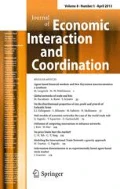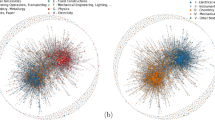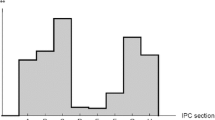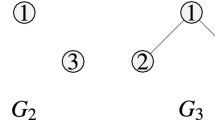[T]he ultimate limits to growth lie not so much in our ability to generate new ideas as in our ability to process an abundance of potentially new ideas into usable form
(M. Weitzman)
Abstract
The literature has documented two patterns of knowledge exchange: free sharing of knowledge and barter exchange. The former has been coined as collective invention, while the latter is observed in the form of R&D alliance. This study, for the first time, compares these two modes of cooperation in creating and diffusing new knowledge. Doing so, we take seriously the network character of knowledge and the skewed distribution of innovation size by proposing a novel model. In this model, knowledge is represented by distinct letters and words constructed thereof and accumulated by agents over time. Discovering new words agents recombine available knowledge pieces not randomly but following certain ideas, semi-definite structures on what words can be further constructed. We proceed by allocating agents in a network and allowing them to cooperate over direct ties either in a regime of collective invention or bilateral R&D alliances. We find networks with skewed degree distribution as most productive under R&D alliances and perfect IPR since they best concentrate scarce resources in discovering different knowledge combinations. In contrast, under collective invention and imperfect IPR, clustered networks better diffuse valuable ideas and knowledge resulting in the overall superior performance. Furthermore, under imperfect IPR, collective invention raises the inequality in payoffs among agents in networks with skewed degree distribution but reduces it for clustered topologies. The latter brings a novel explanation on why industries in the past have experienced a shift in the dominant pattern of knowledge exchange.













Similar content being viewed by others
Notes
As the famous quote says, ‘if you keep everything in-house, you will never generate as much’ (Alexander and Young 1996).
Under perfect IPR and collective invention regime, inequality rises even in clustered networks (compared to R&D alliances), and this is because only one out of the clique can make most valuable discoveries (first-mover advantage).
All capital letters have been replaced and all word containing digits, space or special characters together with the only two one-letter words were dropped resulting in the loss of about 30,000 words.
In the literature, one also finds correlation between patents’ number of citations with their technological importance and social value (Trajtenberg 1990; Albert et al. 1991). Alternatively, one can say that the more new inventions we can discover based on a certain patent, the higher its value (Fink et al. 2017).
In graph theory, clustering refers to the property that two nodes connected to a third node tend to also be connected between themselves.
This implies mutual interest in cooperation with subsequent flow of knowledge in both directions.
Allen (1983) described collective invention as a process in which knowledge was given away as a gift in the Cleveland steel industry to competitors within the local community of engineers.
In reality, of course, share in the joint payoff is subject to the contribution of each partner. However, to avoid complicated assumptions on how the payoffs shall be split, we always share them 50:50. Also, while in reality R&D alliances involving more than two partners take place, those alliances are exclusive and are not formed with all partners simultaneously. Allowing for only two partners per R&D alliance is a simple and convenient way of distinguishing alliances from collective invention.
See Appendix for technical details on how this sampling is implemented.
In particular, an exponential distribution is used. We tested also a normal distribution, and the results have no qualitative difference.
Presence of uncertainty allows agents to recognize a value behind an idea even when it contains no words from the accumulated knowledge stock of the agent.
Setting \(\delta \) too small results in a quick technological lock-in were agents see little possibility to recombine their accumulated knowledge stock, while setting it too large will presume agents foresee very complex technologies without learning enough about their building blocks. We set \(\delta =5\) in our model, but the findings are stable for small variation in this parameter.
If agents realize that the most valuable idea requires elements missing in their accumulated knowledge stock, they simply proceed with the second most valuable idea and so on.
While each agent takes evaluation of ideas by her partner into account at the time of cooperation, she disregards this evaluation afterward, when she, for instance, will consider whether to attempt that idea in a cooperation with a different partner.
It is worth noting that the more knowledge in common two agents have, the less productive is ceteris paribus their mutual effort in recombining new knowledge. In other words, given a fixed number of words and letters two agents have, the more knowledge they have in common, the less they can contribute to the joint pool of knowledge.
This is compatible with the so-called first to file patent rule, where the patent office grants the patent to those who file their application first.
Note that this results in a low network density which is in line with empirical literature (see Cowan and Jonard 2009 for a short review).
Sampling letters following the frequency those letters have in the vocabulary of words used (see Fig. 15 in Appendix) does not qualitatively change the results (similar number and value of words discovered, and the same ranking of scenarios with respect to their productivity and inequality; see Fig. 17) demonstrating robustness of our findings.
As at the very beginning agents have no words yet being generated. Also for the very first f periods, the agents can foresee the list of short words (of two and three letters) to see the value behind the ideas they attempt to realize.
We disregard the first 50 periods with respect to the number and value of words invented to omit the words discovered by purely random recombination.
Note that depending on the scenario in question, a single run of the model takes from 4 to 17 h using computer with four cores and 8 GB RAM. Therefore, we utilize the high-performance computing (HPC) cluster BwUniCluster https://wiki.bwhpc.de/e/Category:BwUniCluster_2.0.
Note again that while in R&D alliance an invention attempt is always an activity initiated by a pair of agents (an edge), in the collective invention regime it is a specific agent (node) that asks her social partners for help but appropriates all the benefits.
In Fig. 18 in Appendix, we show how the distribution of the Gini coefficient for the number of words invented evolves over time. At the very beginning, the inequality is largest because of few words invented by all agents. Within the next thirty to fifty periods the coefficient drops somewhat reaching its long term value and does not change much in subsequent periods.
The condition to be recorded was that the idea was novel for the receiving agent, and its value estimation by that agent was positive.
What is not shown in Fig. 12 but what is happening in reality for non-clustered networks is that when one of the agents gets an idea on what word to produce and shares this idea with her partners, those rarely find it valuable and do not pursue further.
Take an example the recombinant DNA technique recombining 24 distinct technology codes and now being the key technology in the biotechnology industry.
This is equivalent to the Erdös and Rényi (1959) algorithm of generating a random graph.
References
Aghion P, Howitt P (1992) A model of growth through creative destruction. Econometrica 60(2):323–51
Aghion P, Howitt P (1998) On the macroeconomic effects of major technological change. In: Helpman E (ed) General purpose technologies and economic growth. MIT Press, Cambridge, Massachusetts, pp 121–144
Albert M, Avery D, Narin F, McAllister P (1991) Direct validation of citation counts as indicators of industrially important patents. Res Policy 20:251–259
Alexander M, Young D (1996) Strategic outsourcing. Long Range Plan 29(1):116–119
Allen R (1983) Collective invention. J Econ Behavior Organ 4:1–24
Ardito L, Messeni Petruzzelli A, Pascucci F, Peruffo E (2019) Inter-firm R&D collaborations and green innovation value: the role of family firms involvement and the moderating effects of proximity dimensions. Bus Strategy Environ 28(1):185–197
Arthur W, Polak W (2006) The evolution of technology within a simple computer model. Complexity 11(5):23–31
Barabási A, Albert R (1999) Emergence of scaling in random networks. Science 286(5439):509–512
Baum JAC, Cowan R, Jonard N (2010) Network-independent partner selection and the evolution of innovation networks. Manag Sci 56(11):2094–2110
Bessen J, Nuvolari A (2015) Knowledge sharing among inventors: some historical perspectives. In: Harhoff D, Lakhani K (eds) Revolutionizing innovation, users, communities and open innovation. MIT Press, Cambridge
Bresnahan T, Trajtenberg M (1995) General purpose technologies ‘engines of growth? J Econom 65(1):83–108
Burt R (1992) Structural holes: the social structure of competition. Harvard University Press, Cambridge
Capaldo A, Messeni Petruzzelli A (2011) In search of alliance-level relational capabilities: Balancing innovation value creation and appropriability in R&D alliances. Scand J Manag 27:273–286
Capaldo A, Messeni Petruzzelli A (2014) Partner geographic and organizational proximity and the innovative performance of knowledge-creating alliances. Eur Manag Revue 11:63–84
Capaldo A, Petruzzelli AM (2015) Origins of knowledge and innovation in R&D alliances: a contingency approach. Technol Anal Strateg Manag 27(4):461–483
Carayol N, Roux P (2009) Knowledge flows and the geography of networks: a strategic model of small world formation. J Econ Behav Organ 71(2):414–427
Cassiman B, Veugelers R (2006) In search of complementarities in the innovation strategy: internal r&d and external knowledge acquisition. Manag Sci 52(1):68–82
Cohen W, Levinthal D (1990) Absorptive capacity: a new perspective on learning and innovation. Admin Sci Q 35(1):128–152
Cowan R (2005) Network models of innovation and knowledge diffusion. In: Breschi S, Malerba F (eds) Clusters, networks and innovation. Oxford University Press, Oxford
Cowan R, Jonard N (2004) Network structure and the diffusion of knowledge. J Econ Dyn Control 28(8):1557–1575
Cowan R, Jonard N (2007) Structural holes, innovation and the distribution of ideas. J Econ Interact Coord 2(2):93–110
Cowan R, Jonard N (2009) Knowledge portfolios and the organization of innovation networks. Acad Manag Rev 34(2):320–342
Cowan R, Jonard N, Zimmermann J (2007) Bilateral collaboration and the emergence of innovation networks. Manag Sci 53(7):1051–1067
Dawid H, Hellmann T (2014) The evolution of R&D networks. J Econ Behav Organ 105(2014):158–172
Dosi G (1982) Technological paradigms and technological trajectories: a suggested interpretation of the determinants and directions of technical change. Res Policy 11(3):147–162
Dresselhaus M (2001) Burn and interrogate. Science 292(5517):650–651
Egbetokun A, Savin I (2014) Absorptive capacity and innovation: When is it better to cooperate? J Evolut Econ 24(2):399–420
Elia S, Messeni Petruzzelli A, Piscitello L (2019) The impact of cultural diversity on innovation performance of MNC subsidiaries in strategic alliances. J Bus Res 98:204–213
Erdös P, Rényi A (1959) On random graphs I. Publ Math 6:290–297
Fink TMA, Reeves M, Palma R et al (2017) Serendipity and strategy in rapid innovation. Nat Commun 8:2002. https://doi.org/10.1038/s41467-017-02042-w
Fleming L (2002) Finding the organizational sources of technological breakthroughs: the story of Hewlett Packard’s thermal inkjet. Ind Corp Change 11(5):1059–1084
Fleming L, Sorenson O (2004) Science as a map for technological search. Strateg Manag J 25:909–928
Gambardella A, Harhoff D, Verspagen B (2008) The value of European patents. Eur Manag Rev 5(2):69–84
Hall B, Jaffe A, Trajtenberg M (2005) Market value and patent citations. Rand J Econ 36:16–38
Harhoff D, Narin F, Scherer F, Vopel K (1999) Citation frequency and the value of patented inventions. Rev Econ Stat 81(3):511–515
Henderson R, Clark K (1990) Architectural innovation. Admin Sci Q 35(1):9–30
Hidalgo C, Hausmann R (2009) The building blocks of economic complexity. Proc Natl Acad Sci USA 106(26):10,570–10,575
Kauffman S (1993) The origins of order. Oxford University Press, Oxford
Konc T, Savin I (2019) Social reinforcement with weighted interactions. Phys Rev E 100(2):022,305
Korzinov V, Savin I (2018) General purpose technologies as an emergent property. Technol Forecast Social Change 129:88–104
Messeni Petruzzelli A (2008) Proximity and knowledge gatekeepers. the case of the Polytechnic University of Turin. J Knowl Manag 12:34–51
Morone P, Taylor R (2004) Knowledge diffusion dynamics and network properties of face-to-face interactions. J Evolut Econ 14(3):327/351
Mowery DC, Oxley JE, Silverman BS (1996) Strategic alliances and interfirm knowledge transfer. Strat Manag J 17:77–91
Mowery DC, Oxley JE, Silverman BS (1998) Technological overlap and interfirm cooperation: implications for the resource-based view of the firm. Res Policy 27(5):507–523
Mowery W, White D, Koput K, Owen-Smith J (2005) Network dynamics and field evolution: the growth of interorganizational collaboration in the life sciences. Am J Sociol 110:1132–1205
Mueller M, Bogner K, Buchmann T, Kudic M (2017) The effect of structural disparities on knowledge diffusion in networks: an agent-based simulation model. J Econ Interact Coord 12(3):613–634
Nelson R, Winter S (1982) An evolutionary theory of economic change. Cambridge University Press, Cambridge
Nooteboom B (2000) Learning and innovation in organizations and economies. Oxford University Press, Oxford
Osterloh M, Rota S (2007) Open source software development—just another case of collective invention? Res Policy 36(2):157–171
Owen-Smith J, Powell W (2004) Knowledge networks as channels and conduits: the effects of spillovers in the Boston biotechnology community. Organ Sci 15(1):5–21
Powell W (1990) Neither markets nor hierarchies: network forms of organization. Res Organ Behav 12:295–336
Powell W, Giannella E (2010) Collective invention and inventor networks. In: Hall H, Rosenberg N (eds) Handbook of the economics of innovation, vol 1. North Holland, Elsevier, pp 576–605
Ravasz E, Barabasi A (2003) Hierarchical organization in complex networks. Phys Rev E 67(026):112
Romer P (1990) Endogenous technological change. J Polit Econ 98(5):S71–S102
Sampson RC (2007) R&D alliances and firm performance: the impact of technological diversity and alliance organization on innovation. Acad Manag J 50(2):364–386
Savin I, Egbetokun A (2016) Emergence of innovation networks from R&D cooperation with endogenous absorptive capacity. J Econ Dyn Control 64:82–103
Savino T, Petruzzelli A, Albino V (2017) Search and recombination process to innovate: a review of the empirical evidence and a research agenda. Int J Manag Rev 19:54–75
Schmiedeberg C (2008) Complementarities of innovation activities: an empirical analysis of the German manufacturing sector. Res Policy 37(9):1492–1503
Schumpeter J (1912/1934) The theory of economic development. Harvard University Press
Sigman M, Cecchi G (2002) Global organization of the wordnet lexicon. Proc Natl Acad Sci USA 99(3):1742–1747
Silverberg G (1991) Adoption and diffusion of technology as a collective evolutionary process. Technol Forecast Soc Change 39(1–2):67–80
Silverberg G, Verspagen B (2007) The size distribution of innovations revisited: an application of extreme value statistics to citation and returns measures of patent significance. J Econom 127(2):318–339
Sole R, Corominas-Murtra B, Valverde S, Steels L (2010) Language networks; their structure, function and evolution. Complexity 15:20–26
Stuart T (2000) Interorganizational alliances and the performance of firms: a study of growth and innovation rates in a high-technology industry. Strat Manag J 21(8):791–811
Trajtenberg M (1990) A penny for your quotes: patent citations and the value of innovations. Rand J Econ 21:172–187
Uzzi B, Spiro J (2005) Collaboration and creativity: the small world problem. Am J Sociol 111(2):447–504
Uzzi B, Mukherjee S, Stringer M, Jones B (2013) Atypical combinations and scientific impact. Science 342(6157):468–472
Valverde S, Solé R, Bedau M, Packard N (2007) Topology and evolution of technology innovation networks. Phys Rev E 76(5):056,118
Vincenti W (1990) What engineers know, and how they know it. Johns Hopkins University Press, Baltimore
von Hippel E (1987) Cooperation between rivals: informal know-how trading. Res Policy 16:291–302
Walker G, Kogut B, Shan W (1997) Social capital, structural holes and the formation of an industry network. Organ Sci 8:108–125
Wang N, Xiao M, Savin I (2020) Complementarity effect in the innovation strategy: internal R&D and acquisition of capital with embodied technology. J Technol Transf (forthcoming)
Watts DJ, Strogatz S (1998) Collective dynamics of small-world networks. Nature 393(6684):440–442
Weitzman ML (1998) Recombinant growth. Q J Econ 113(2):331–360
Youn H, Strumsky D, Bettencourt L, Lobo J (2015) Invention as a combinatorial process: evidence from US patents. J R Soc Interface 12:20150,272
Zook C, Rigby D (2002) Open-market innovation. Harvard Bus Rev 80(10):80–89
Author information
Authors and Affiliations
Corresponding author
Additional information
Publisher's Note
Springer Nature remains neutral with regard to jurisdictional claims in published maps and institutional affiliations.
Financial support from the Russian Science Foundation (RSF Grant Number 19-18-00262) is gratefully acknowledged. I would also like to thank Robin Cowan, Elizaveta Zasukhina and Théo Konc for many constructive comments on earlier drafts of the paper. This work has benefited from presentations at workshops in Karlsruhe, Strasbourg, Maastricht, Yekaterinburg as well as from ISS congress in Seoul. All remaining shortcomings are my responsibility.
Appendices
Appendix
The four stylized network topologies have been implemented as follows:
-
The regular (periodic) lattice represents a network in which agents are connected with few nearest neighbors (the number must be even, and is equal to four in our case). The resulting network has highest clustering (i.e., partners of my partners tend to be partners as well), no degree asymmetry (everyone has the same number of edges) and relatively high mean path length (average number of edges to connect any two agents in the network).
-
The small world network is constructed out of regular lattice following Watts and Strogatz (1998) by sequentially considering each edge and rewiring it to a different randomly chosen node with a small probability p (typically between 1% and 10%, we use 5%). The distinct property of small world network is that for the small p the average clustering remains high, while mean path lengths drops dramatically. The degree distribution becomes (slightly) skewed.
-
The random network is constructed by applying the Watts–Strogatz algorithm but with a 100% probability of rewiring each link.Footnote 27 The resulting network becomes completely disordered with negligible clustering, short average path length and higher degree asymmetry.
-
Finally, to construct the scale-free network, the algorithm proposed by Barabási and Albert (1999) is used. Its formation intuition is the preferential attachment mechanism implying that more connected nodes are more likely to receive new links. As a result, one obtains a graph with a high asymmetry in degree distribution following a power law (we use a power exponent \(\gamma \) equaling 3), shortest average path length among the considered networks and low clustering.
A graphical representation of the four networks together with the estimates of their structural properties is given in Fig. 14. All four network topologies are implemented to produce a connected graph, i.e., it is possible to get from every node in the graph to every other node in the graph through a series of edges, called a path.
Regular | Small world | Random | Scale free | |
|---|---|---|---|---|
Clustering | 0.50 | 0.38 | 0.04 | 0.11 |
(0.00) | (0.03) | (0.01) | (0.03) | |
Mean path length | 12.88 | 5.11 | 3.45 | 3.08 |
(0.00) | (0.44) | (0.07) | (0.07) | |
Degree asymmetry | 0.00 | 0.15 | 0.47 | 0.86 |
(0.00) | (0.02) | (0.03) | (0.08) |
Four stylized networks considered. Note: The networks illustrated have a regular, b small world, c random and d scale-free topology. The parameters are chosen according to the baseline scenario specified in Table 1. Degree asymmetry is measured by the coefficient of variation. Values are reported in averages over 100 replications (with standard deviations in parentheses)
On generating new ideas. A word citing a discovered word is chosen to generate a new idea probabilistically more often if the number of extra letters it contains compared to the cited word is small. More formally, denote the number of extra letters as l. Then, the given word is selected to generate a new idea if
Thus, while words containing one or two extra letters are chosen with a high likelihood (72% and 27%, respectively), words with more than five new letters have very low chance to be selected (see Fig. 16).
Additional results
Number and value of inventions in the perfect IPR regime under alternative letter sampling (see Fig. 15)
Rights and permissions
About this article
Cite this article
Savin, I. On optimal regimes of knowledge exchange: a model of recombinant growth and firm networks. J Econ Interact Coord 16, 497–527 (2021). https://doi.org/10.1007/s11403-020-00314-1
Received:
Accepted:
Published:
Issue Date:
DOI: https://doi.org/10.1007/s11403-020-00314-1









